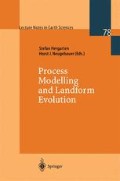Abstract
The surface runoff plays a dominant part in soil erosion during excessive rainfalls. Based on the Manning formula, we present an approach that is applicable to small scales of some centimeters. Thus, structures like rills and hollows can be resolved. The infiltration is taken into account using the Richards equation. The resulting coupled differential equation system is solved numerically.
Access this chapter
Tax calculation will be finalised at checkout
Purchases are for personal use only
Preview
Unable to display preview. Download preview PDF.
References
Abrahams, A.D., A.J. Parsons, and J. Wainwright (1994): Resistance to overland flow on semiarid grassland and shrubland hillslopes. Journal of Hydrology, 156:431–446.
Abrahams, A.D., G. Li, and A.J. Parsons (1996): Rill hydraulics on a semiarid hillslope, Southern Arizona. Earth Surface Processes and Landforms, 21:35–47.
de Roo, A.P.J., C.G. Wesseling, N.H.D.T. Cremers, R.J.E. Offermans, C.J. Ritsema, and K. van Oostindie (1994): LISEM: a new physically-based hydrological and soil erosion model in a GIS-environment, theory and implementation. In: Olive, L.J., R.J. Loughran, and J.A. Kesby: Variability in stream erosion and sediment transport, Int Assoc. Hydrol. Sci. Publ. 224, Wallingford.
Emmett, W.W. (1970): The hydraulics of overland flow on hillslopes. U.S. Geological Survey Paper, A:662.
Giles, R. (1962): Theory and problems of fluid mechanics and hydraulics. McGraw-Hill Inc..
Govers, G. (1992): Relationship between discharge, velocity, and flow area for rills eroding in loose, non-layered material. Earth Surface Processes and Landforms, 17:515–528.
Govindaraju, R.S., S.E. Jones, and M.L. Kavvas (1988): On the diffusion wave modeling for overland flow, 1, solution for steep slopes. Water Resour. Res., 24(5): 734–744.
Green, W.H., and G.A. Ampt (1911): Studies on Soil Physics: 1. Flow of air and water through soils. Journal Agric. Sci., 4:1–24.
Hergarten, S., and H.J. Neugebauer (1997): Homogenization of Manning's formula for modeling surface runoff. Geophys. Res. Lett., 24(8):877–880.
Knisel, W.G. (1980): CREAMS — a field scale model for chemicals, runoff, and erosion from agricultural management systems. USDA Conserv Res Report 26, US Dept of Agriculture/Science and Education Administration, Washington, D.C.
Lane, L.J., and M.A. Nearing (1989): USDA — water erosion prediction project: hillslope profile model documentation. NSERL Report 2 (USDA-ARS National Soil Erosion Laboratory), West Lafayette.
Morgan, R.P.C. (1989): USDA — water erosion prediction project: hillslope profile model documentation. NSERL Report 2 (USDA-ARS National Soil Erosion Laboratory), West Lafayette.
Morris, E.M., and D.A. Woolhiser (1980): Unsteady one-dimensional flow over a plane: partial equilibrium and recession hydrographs. Water Resour. Res., 16(2): 355–360.
Pearce, A.J. (1976): Magnitude and frequency of erosion by Hortonian overland flow. Journal of Geology 84:65–80.
Richards, L.A. (1931): Capillary conduction of liquids in porous mediums. Physics, 1:318–333.
Schmidt, J. (1991): A mathematical model to simulate rainfall erosion. In: Bork, H.R., J. de Ploey, and A.P. Schick: Erosion, transport and deposition processes — theory and models.
Smith, R.E. (1992): OPUS — an integrated simulation model for transport of nonpoint-source pollutants at the field scale. I: documentation, US Dept of Agriculture — Soil Conserv Service 98, Washington, D.C.
von Werner, M. (1996): GIS-orientierte Methoden der digitalen Reliefanalyse zur Modellierung von Bodenerosion in kleinen Einzugsgebieten. Dissertation, FU Berlin.
Weltz, M.A., A.B. Arslan, and L.J. Lane (1992): Hydraulic roughness coefficients for native rangelands. Journal of Irrigation and Drainage Engineering, 118:776–790.
Woolhiser, D.A., R.E. Smith, and D.C. Goodrich (1990): KINEROS, a kinematic runoff and erosion model: documentation and user manual. USDA-ARS-77, US Dept of Agriculture — Agriculture Res Service, Washington, D.C.
Zhang, W., and T.W. Cundy (1989): Modeling of two-dimensional overland flow. Water Resour. Res., 25(9): 2019–2035.
Author information
Authors and Affiliations
Editor information
Rights and permissions
Copyright information
© 1999 Springer-Verlag
About this chapter
Cite this chapter
Paul, G., Hergarten, S., Neugebauer, H.J. (1999). Numerical simulation of surface runoff and infiltration of water. In: Hergarten, S., Neugebauer, H.J. (eds) Process Modelling and Landform Evolution. Lecture Notes in Earth Sciences, vol 78. Springer, Berlin, Heidelberg. https://doi.org/10.1007/BFb0009721
Download citation
DOI: https://doi.org/10.1007/BFb0009721
Published:
Publisher Name: Springer, Berlin, Heidelberg
Print ISBN: 978-3-540-64932-8
Online ISBN: 978-3-540-68307-0
eBook Packages: Springer Book Archive

